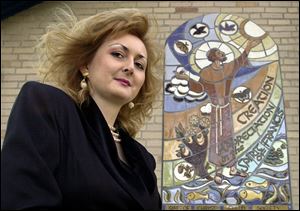
Free to glorify God: Creator of religious murals fled communism
11/3/2001
Svetlana Cholvadova's ceramic murals include this four-foot-by-six-foot tribute to St. Francis of Assisi on display at Lourdes College in Sylvania.
Every year, Svetlana Cholvadova took an intensive, week-long entrance exam to study art at the universities near her village of Hybe, Slovakia. Every year, she passed the test easily but was turned down for admission.
Years later, Miss Cholvadova found out why: “I was persecuted because I went to church.”
The pastor at her Evangelical Lutheran church in Slovakia was also an agent for the communist government, she said, and he reported to authorities that she was a church-going Christian.
Miss Cholvadova, 33, came to Toledo in 1992 to study art after she realized that her hopes for an art career would never materialize under a communist regime that distrusted and harassed Christians.
She had met two Toledoans, Gene and Betty Cerveny, when they visited Slovakia and later wrote to them asking for help in finding a U.S. sponsor.
“She was having a hard time getting into school as an art student,” Mrs. Cerveny said. “We invited her to spend a few months with us.”
Moving to America was tougher on her parents than it was on her, Miss Cholvadova said, because she was an only child. But she knew that it was necessary to make the most of her artistic gifts.
In the meantime, she had been taking private art lessons and studied all aspects of art. She developed a fondness for painting portraits of senior citizens in their colorful ethnic costumes that vary from village to village. “There is nothing more beautiful than old people, with all the wrinkles,” Miss Cholvadova said.
When she arrived in America, barely able to speak English at the time, the Cervenys took her to visit area colleges and universities.
“I fell in love with Lourdes College,” Miss Cholvadova said, speaking fluent English with an exotic accent. “It is so European - in its architecture, its atmosphere, everything.”
She received financial help for her first semester's tuition from a local resident and later an anonymous donor paid for the rest of her tuition through graduation, with honors, in 1998. “It was like a blessing from the skies,” Miss Cholvadova said of the contributions.
She was drawn to the ceramic murals of Christian symbols and saints, drawn in a Byzantine style of elongated features, that are the specialty of Sister Jane Mary Sorosiak. There were no courses offered on this type of art at Lourdes but the nun personally encouraged Miss Cholvadova.
“In 1994, I was a student here and I said to Sister Jane Mary, `What are you doing? Can I come and help you?' And she said, `Oh, sure!'”
Sister Jane Mary began teaching Miss Cholvadova each step of the lengthy process involved in creating large-scale ceramic murals.
The first detail is to study the wall where the mural will be placed. It has to be sturdy enough to support the weight of the clay, which can be 500 pounds or more. The best surface is unpainted cinder block on a load-bearing wall, she said.
Then Miss Cholvadova, who does in-depth research on the religious symbols and themes for each project, draws several black-and-white sketches of possible designs before narrowing them down to one. Then she creates several color schemes, again boiling it down to one.
Next, she rolls out the clay in 75-pound sections and traces the design on them. The clay is cut into individual pieces and “low-fired” in a kiln at 1,500 to 1,800 degrees Fahrenheit. Then she individually creates each colored glaze and paints the pieces, which are then “high-fired” in a kiln at 2,000 to 2,400 degrees.
The pieces are all numbered, carefully wrapped in newspaper, packed into boxes, and hauled to the site where the mural is laid out on the floor next to the wall where it will be installed. Miss Cholvadova oversees the installation but hires a professional bricklayer to cement the pieces to the wall and then add the grout.
Her first commissioned project, passed along by Sister Jane Mary, came in 1997 for a small mural that accented a statue at Our Lady of Mount Carmel Catholic Church in Temperance. The next year, she was hired to create a wall-sized mural on communion for St. John the Baptist Church in Point Place.
In 1999, Miss Cholvadova was hired to create a 14-by-7-foot mural of Jesus surrounded by children at a new school that was being added on to St. Fabian Catholic Church in the Detroit suburb of Farmington Hills, Mich. The elaborate scene required 550 pounds of clay cut into 310 pieces that were transported in 15 boxes.
St. Fabian then commissioned her for a second mural, a 10-by-15-foot sign with the church's name on an outside wall.
One of Miss Cholvadova's most visible ceramic works is a 4-by-6-foot daytime scene of St. Francis of Assisi, installed last year on an exterior wall at Lourdes College. She said she is working on a companion piece that will feature a nocturnal scene of St. Francis.
She is also planning a large outdoor mural for a church in Southfield, Mich., that she has been commissioned to create.
Just last week, Miss Cholvadova had a ceramic triptych installed at her home church, Olivet Lutheran in Sylvania. The theme of the three panels is baptism.
“It seemed that every church in the area has my murals except my own,” she said. “I wanted to show my gratitude, so I donated the triptych.”
Miss Cholvadova, who has formed her own company, Sculptured Mosaics, said her goal “is to create something beautiful to look at that will lead people to God. God has done so many good things in my life and I want my work to be a glorification of God.”